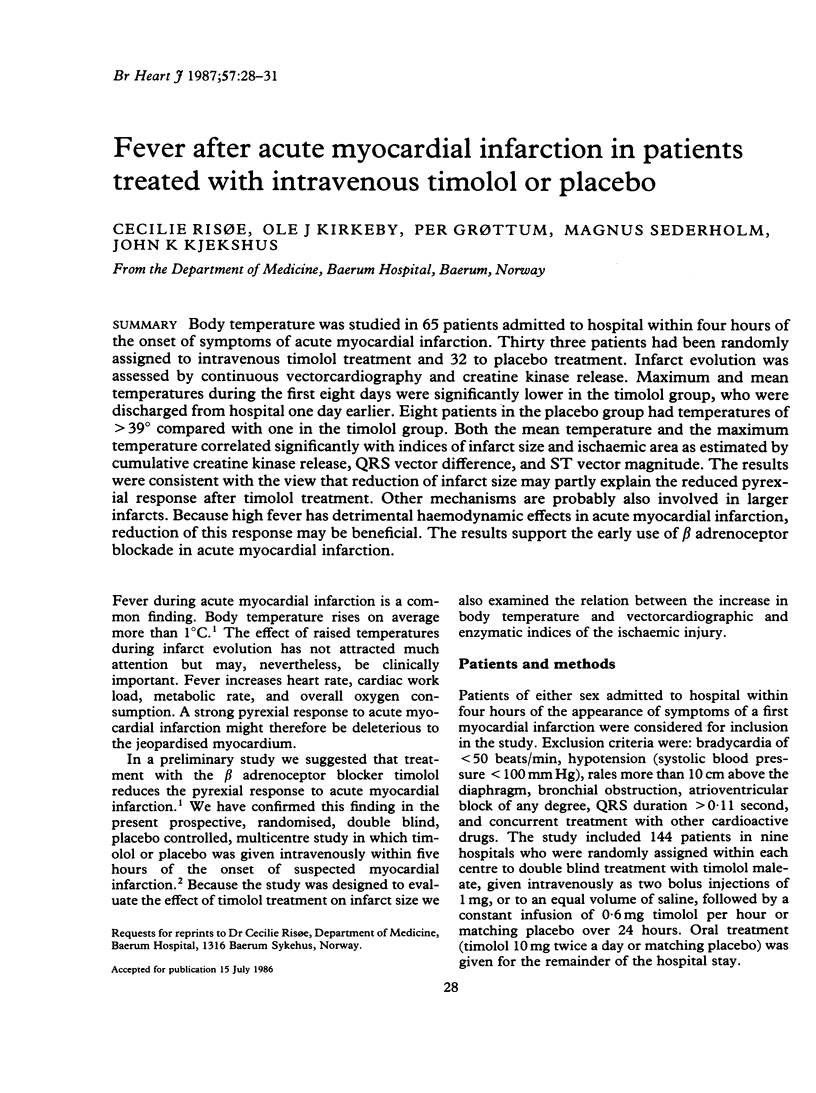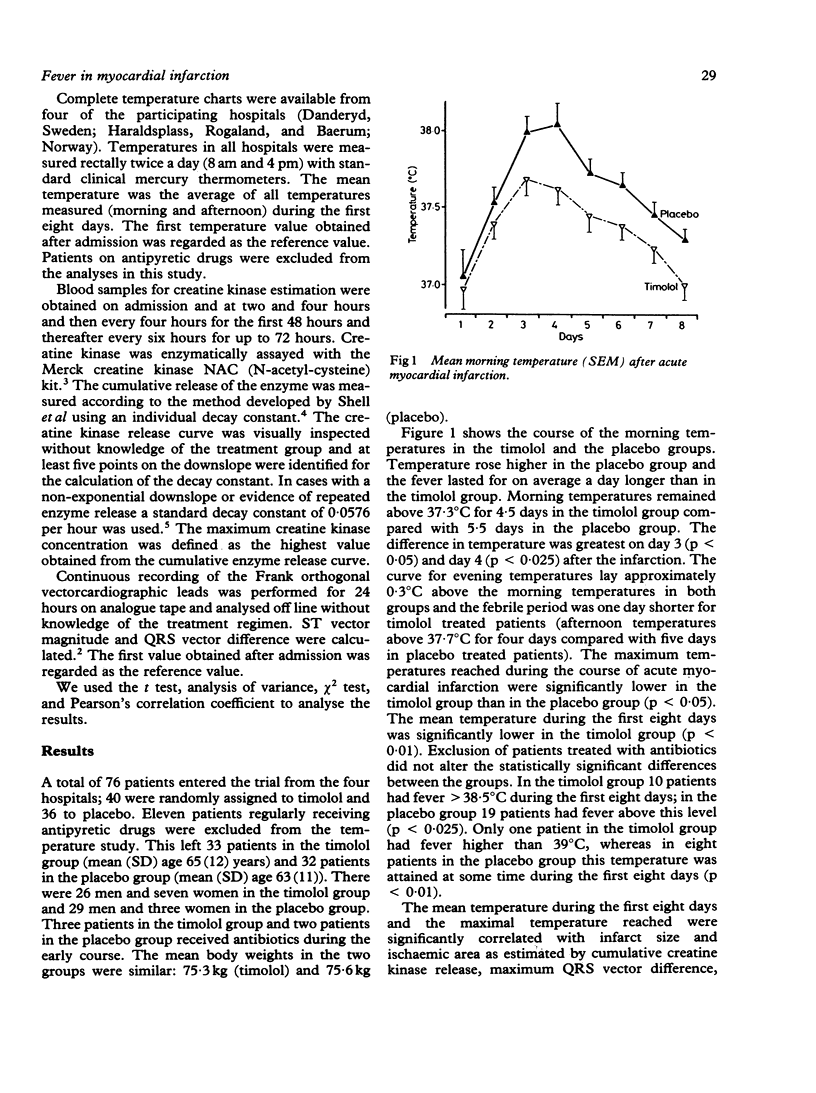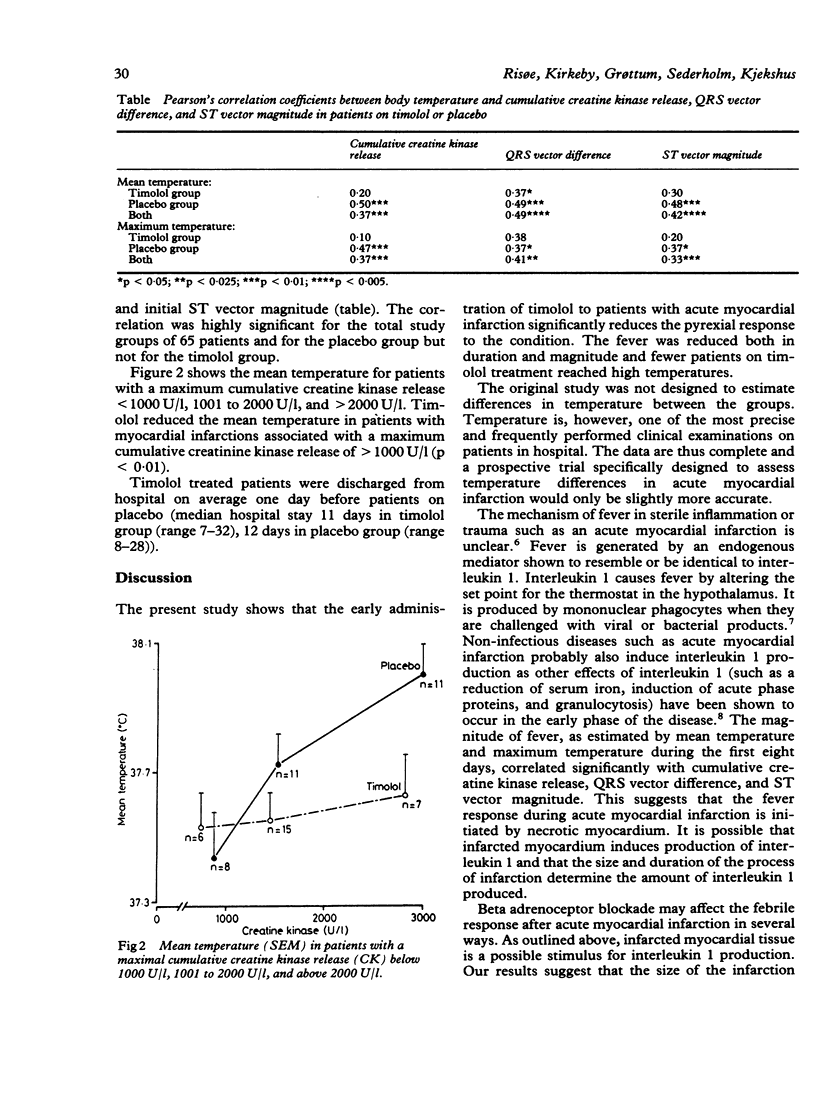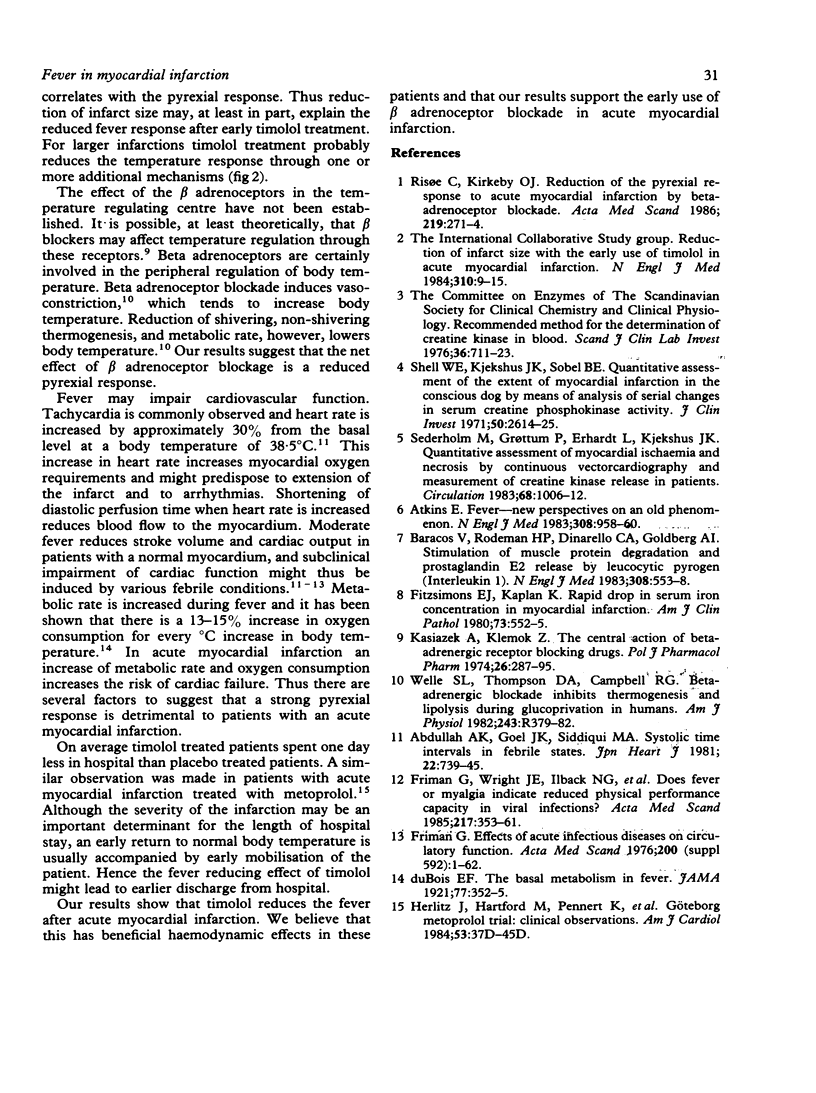Abstract
Body temperature was studied in 65 patients admitted to hospital within four hours of the onset of symptoms of acute myocardial infarction. Thirty three patients had been randomly assigned to intravenous timolol treatment and 32 to placebo treatment. Infarct evolution was assessed by continuous vectorcardiography and creatine kinase release. Maximum and mean temperatures during the first eight days were significantly lower in the timolol group, who were discharged from hospital one day earlier. Eight patients in the placebo group had temperatures of greater than 39 degrees compared with one in the timolol group. Both the mean temperature and the maximum temperature correlated significantly with indices of infarct size and ischaemic area as estimated by cumulative creatine kinase release, QRS vector difference, and ST vector magnitude. The results were consistent with the view that reduction of infarct size may partly explain the reduced pyrexial response after timolol treatment. Other mechanisms are probably also involved in larger infarcts. Because high fever has detrimental haemodynamic effects in acute myocardial infarction, reduction of this response may be beneficial. The results support the early use of beta adrenoceptor blockade in acute myocardial infarction.
Full text
PDF



Selected References
These references are in PubMed. This may not be the complete list of references from this article.
- Abdullah A. K., Goel J. K., Siddiqui M. A. Systolic time intervals in febrile states. Jpn Heart J. 1981 Sep;22(5):739–745. doi: 10.1536/ihj.22.739. [DOI] [PubMed] [Google Scholar]
- Atkins E. Fever--new perspectives on an old phenomenon. N Engl J Med. 1983 Apr 21;308(16):958–969. doi: 10.1056/NEJM198304213081610. [DOI] [PubMed] [Google Scholar]
- Baracos V., Rodemann H. P., Dinarello C. A., Goldberg A. L. Stimulation of muscle protein degradation and prostaglandin E2 release by leukocytic pyrogen (interleukin-1). A mechanism for the increased degradation of muscle proteins during fever. N Engl J Med. 1983 Mar 10;308(10):553–558. doi: 10.1056/NEJM198303103081002. [DOI] [PubMed] [Google Scholar]
- Fitzsimons E. J., Kaplan K. Rapid drop in serum iron concentration in myocardial infarction. Am J Clin Pathol. 1980 Apr;73(4):552–555. doi: 10.1093/ajcp/73.4.552. [DOI] [PubMed] [Google Scholar]
- Friman G. Effects of acute infectious disease on circulatory function. Acta Med Scand Suppl. 1976;592:1–62. [PubMed] [Google Scholar]
- Friman G., Wright J. E., Ilbäck N. G., Beisel W. R., White J. D., Sharp D. S., Stephen E. L., Daniels W. L., Vogel J. A. Does fever or myalgia indicate reduced physical performance capacity in viral infections? Acta Med Scand. 1985;217(4):353–361. doi: 10.1111/j.0954-6820.1985.tb02709.x. [DOI] [PubMed] [Google Scholar]
- Herlitz J., Hartford M., Pennert K., Waagstein F., Waldenström A., Wedel H., Wilhelmsson C., Hjalmarson A. Göteborg Metoprolol Trial: clinical observations. Am J Cardiol. 1984 Jun 25;53(13):37D–45D. [PubMed] [Google Scholar]
- Ksiazek A., Kleinrok Z. The central action of beta-adrenergic receptor blocking agents. I. The central action of intraventricularly administered isoprenaline in the rat. Pol J Pharmacol Pharm. 1974 May-Jun;26(3):287–295. [PubMed] [Google Scholar]
- Risøe C., Kirkeby O. J. Reduction of the pyrexial response to acute myocardial infarction by beta-adrenoceptor blockade. Acta Med Scand. 1986;219(3):271–274. doi: 10.1111/j.0954-6820.1986.tb03310.x. [DOI] [PubMed] [Google Scholar]
- Sederholm M., Grøttum P., Erhardt L., Kjekshus J. Quantitative assessment of myocardial ischemia and necrosis by continuous vectorcardiography and measurement of creatine kinase release in patients. Circulation. 1983 Nov;68(5):1006–1012. doi: 10.1161/01.cir.68.5.1006. [DOI] [PubMed] [Google Scholar]
- Shell W. E., Kjekshus J. K., Sobel B. E. Quantitative assessment of the extent of myocardial infarction in the conscious dog by means of analysis of serial changes in serum creatine phosphokinase activity. J Clin Invest. 1971 Dec;50(12):2614–2625. doi: 10.1172/JCI106762. [DOI] [PMC free article] [PubMed] [Google Scholar]
- Welle S. L., Thompson D. A., Campbell R. G. Beta-adrenergic blockade inhibits thermogenesis and lipolysis during glucoprivation in humans. Am J Physiol. 1982 Sep;243(3):R379–R382. doi: 10.1152/ajpregu.1982.243.3.R379. [DOI] [PubMed] [Google Scholar]


